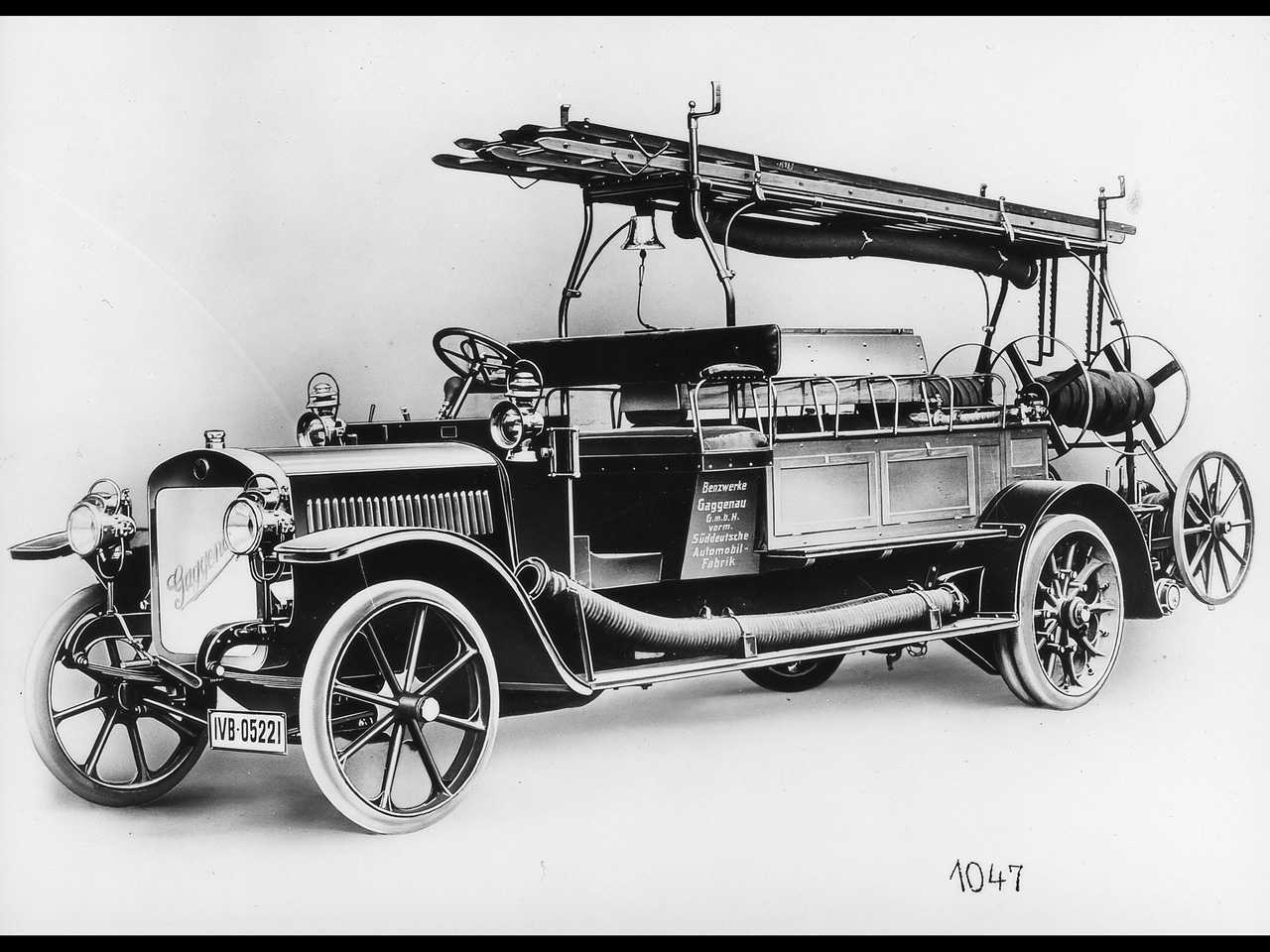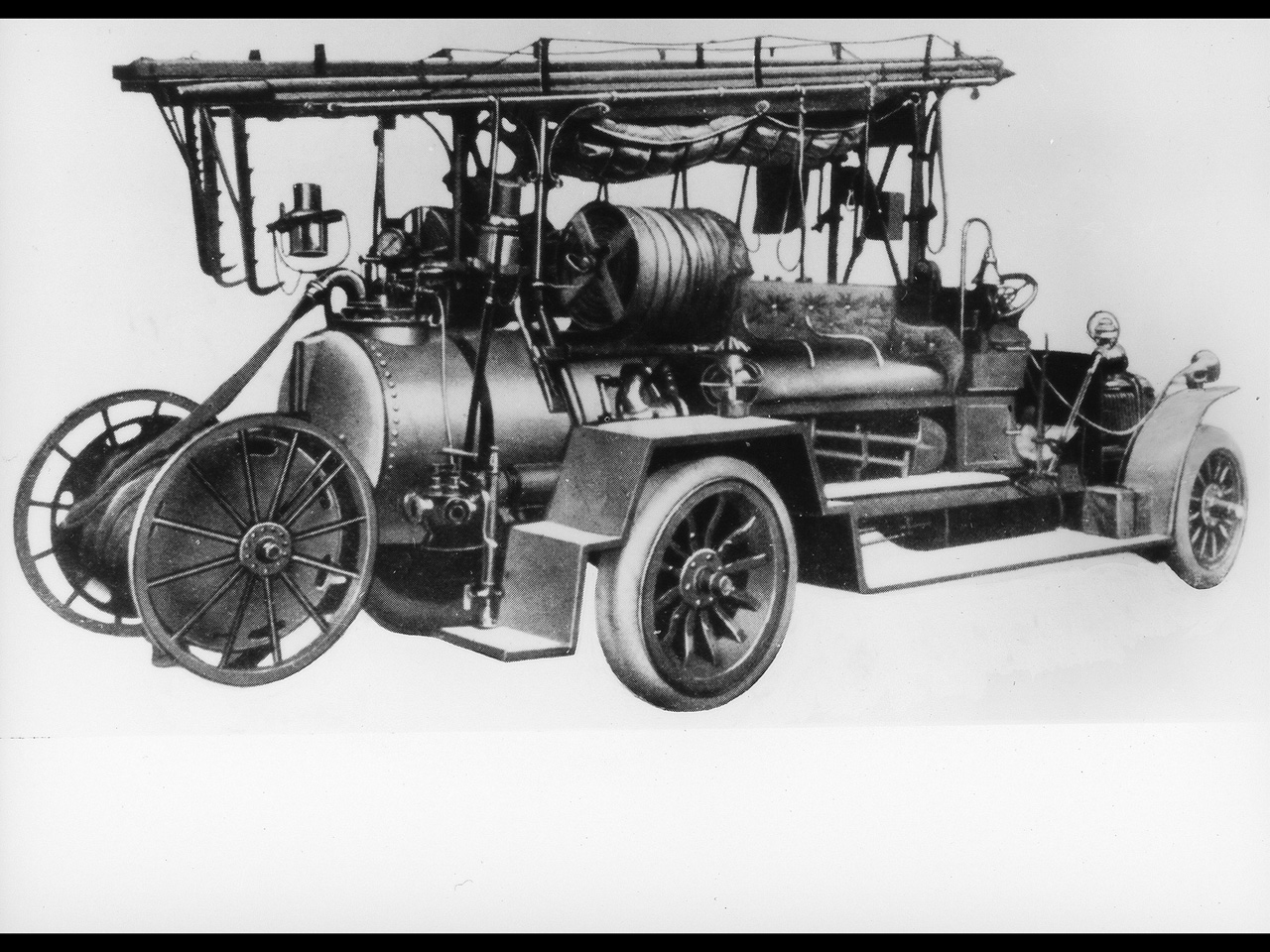1906 Benz Grunewald Fire-Fighting Pump
|
Price |
15,000 marks |
Production |
-- | ||
|
Engine |
-- |
Weight |
-- | ||
|
Aspiration |
-- |
Torque |
-- | ||
|
HP |
40 hp |
HP/Weight |
-- | ||
|
HP/Liter |
-- |
1/4 mile |
-- | ||
|
0-62 mph |
-- |
Top Speed |
-- |
(from Daimler Press Release) Pioneering development by SAG in Gaggenau. Output of up to 40 horsepower
One hundred years ago, the worlds first fire-fighting pump powered by a gasoline engine was supplied to the customer and put into operation in the Grunewald suburb of Berlin on December 1, 1906. It was a three-tonner with four-cylinder engine, built by Sddeutsche Automobilfabrik Gaggenau (SAG, South German Automobile Factory), a company which was integrated in Benz & Cie. a little later.
A brochure published by Benz & Cie. on the occasion of a hygiene exhibition in Stuttgart in 1914 had this to say in retrospect: The Benz factory in Gaggenau was the first to supply a fire-fighting vehicle powered by an explosion engine, and it still occupies first place not only with respect to the number of vehicles supplied but also in terms of operational safety and vehicle performance. At that point in time, a lot had happened ever since the fire-fighting pumps arrival in Berlin on December 1, 1906. SAG, founded in 1905, got into difficulties as early as 1907 and, from January 1, 1911, officially operated under the name Benz-Werke Gaggenau GmbH. Where self-propelled fire-fighting vehicles were concerned, the gasoline engine had slowly but steadily prevailed against the electric motor and the steam engine.
Strong competition from electric drive
In 1906, the situation had still been completely different. The first self-propelled fire-fighting combination, consisting of two electrically driven vehicles and a steam-powered pump, had gone into operation in Hanover as late as 1902. The Chief Fire Officer responsible, Maximilian Reichel, had meanwhile changed from Hanover to Berlin and taken an interest in the novel wheel-hub motors of the Lohner-Porsche type offered by Daimler-Motoren-Gesellschaft from 1906. The Lohner-Porsche system had been invented by young Ferdinand Porsche who had been working for Jacob Lohner in Vienna from 1899 and for Austro-Daimler from 1905.
It was certainly no coincidence that the voluntary fire brigade of Grunewald was the first in Germany to take an interest in gasoline engines quite a few of the well-to-do inhabitants of the posh suburb were proud owners of automobiles. These were approached by Fire Brigade Commander Ratig with a request for donations for the acquisition of a gasoline-powered fire-fighting pump. The voluntary fire brigade had acquired a motorized three-wheeler as early as 1901 and a passenger car with equipment trailer in 1905. Sddeutsche Automobilfabrik, in its turn, was not totally unknown in Berlin. Just one year earlier, it had supplied a large-capacity bus for 52 passengers to the capital.
Good relations between Gaggenau and Berlin
The fire-fighting pump marketed by SAG as the Grunewald Type from 1907 weighed in at 2.43 tons. It accommodated six fire-fighters on two longitudinally arranged back-to-back benches behind the drivers seat. Behind the benches, there was space for the tank for the gas pump, several hose drums and other equipment. The vehicle was available with engines developing 22, 32 and 40 hp and cost 14,000, 14,500 and 15,000 marks, respectively. Engine power was transmitted to the twin solid-rubber rear wheels by means of a chain. The front wheels were fitted with pneumatic tires in size 850 x 125 millimeters. According to the manufacturer, the fire-fighting pump reached a top speed of 35 km/h and was capable of climbing 16-percent gradients.
The development of self-propelled fire-fighting pumps was spurred on by the fact that neither the horse-drawn steam-powered pumps nor the electrically powered pumps had an adequate operating range. In a neighboring city, they were reported to have failed on the third assignment after having answered two fire alarms on one and the same day, requiring recourse to the manger and the electricity recharging station, respectively, wrote SAG three years later in a brochure specially printed after a major fire in Karlsruhe, where the steam pump proved its effectiveness in a case of emergency for the first time. We succeeded in easily accommodating three functions in our vehicle. The latter can be used firstly as a gas pump, secondly as a crew and equipment carrier and thirdly as a steam pump.
Up to 50-meter-high jet
The brochure also refers to a report in the evening edition of Badische Presse of December 15, 1909: In fighting this fire, the new self-propelled fire-fighting pump performed outstandingly well. Thanks to its high speed in reaching the scene of a fire and the speed at which it goes into action, it is predestined for being the first to arrive at the scene of a fire and start extinguishing work straightaway until the other pumps have arrived and been put into operation. The self-propelled fire-fighting pump powered by an engine from Gaggenau operated uninterruptedly from 10.45 p.m. yesterday until 4.45 a.m. this morning, spraying water through four mighty hoses at a pressure of six to seven bar into the raging fire, up to a height of some 40 to 50 meters.



